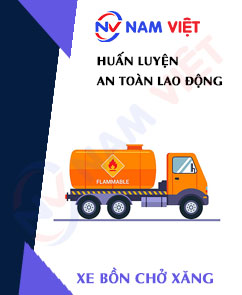Occupational Safety Training for Operating Fuel Tanker Trucks
99,000 ₫
Note: The above price is calculated for one person and may fluctuate depending on the number of participants in the course and market dynamics. For more accurate pricing support, please refer to the pricing table or contact our consulting staff directly.
Occupational safety is an important issue when operating a fuel tanker truck and needs to be addressed promptly to ensure the health and safety of workers and enhance the reputation of businesses here. The Occupational Safety Training course is one of the effective solutions to raise awareness of how to prevent workplace accidents for workers when operating a fuel tanker truck.
Table of Contents
Toggle1. Overview of Gasoline Tanker Trucks
a. What is a Gasoline Tanker Truck?
A gasoline tanker truck, also known as a “gasoline tanker truck” in English, is a vehicle specifically designed to transport gasoline from one location to another. They are commonly used in the oil and petroleum industry to deliver fuel from production facilities or storage depots to gas stations and other distribution points.
Gasoline tanker trucks have a large tank capable of holding thousands to tens of thousands of gallons of gasoline, depending on the truck’s size and model. The tank is usually made of fire-resistant materials to ensure safety when transporting flammable liquids like gasoline.

b. Operating Principles of Gasoline Tanker Trucks
The operating principles of gasoline tanker trucks mainly involve safely transporting gasoline from the point of origin to the destination. Key aspects include:
- Tank:
- Explosion-Proof Material: The tank is typically made of fire-resistant material to minimize the risk of fire or explosion.
- Size and Capacity: The tank is designed to hold large amounts of gasoline, usually from thousands to tens of thousands of gallons, depending on the truck’s model and purpose.
- Pump and Piping System:
- Pump System: Gasoline tanker trucks often have specialized pumps to move gasoline from the tank to nozzles or designated delivery points.
- Piping and Connections: High-pressure pipelines ensure gasoline is delivered safely and efficiently.
- Safety System:
- Safety Valves: Equipped to control tank pressure and prevent potential explosions.
- Leak Sensors: Sensors can detect gasoline leaks and alert the operator.
- Control and Monitoring System:
- Control System: Modern gasoline tanker trucks often include automated monitoring systems for safe transportation.
- Control Panel: Operators can manage vehicle functions via the panel, including monitoring fuel levels and adjusting valves and pumps.
- Traffic Safety:
- Warning Lights: Tanker trucks have lights and safety signs to alert other road users of their presence.
- Compliance with Regulations: Operators must adhere to traffic safety laws when transporting gasoline.

c. Industries Using Gasoline Tanker Trucks
Gasoline tanker trucks are mainly used in the oil, petroleum, and energy sectors to transport gasoline and other essential fuels. Key industries include:
- Oil Industry:
- Energy companies, such as oil and gas producers, use gasoline tanker trucks to transport gasoline from production sites to distribution points or gas stations.
- Energy Sector:
- Power plants and energy production facilities may use gasoline tanker trucks to supply fuel for energy generation systems and equipment.
- Transportation Sector:
- Transport companies may use gasoline tanker trucks to fuel their vehicle fleets or deliver gasoline to various locations.
- Petroleum Retail:
- Businesses in fuel distribution and retail use gasoline tanker trucks to supply gas stations and other retail outlets.
- Construction and Industrial Sector:
- During construction and industrial operations, tanker trucks may provide fuel for machinery and equipment.
- Military:
- Military forces use gasoline tanker trucks to supply fuel for vehicles and facilities.
2. Overview of Safety Training for Operating Gasoline Tanker Trucks
a. What is Occupational Safety Training?
- Occupational safety training for operating gasoline tanker trucks equips workers with knowledge and awareness to prevent workplace accidents. Workers who directly operate these trucks belong to Group 3.
- Training helps workers identify and avoid hazards, reducing the risk of workplace accidents.
REGISTER FOR OCCUPATIONAL SAFETY TRAINING SERVICE
b. Training Duration
Initial safety training
- Total training time is at least 24 hours, including examination time.
- 8 hours of theory on occupational safety laws and policies
- 8 hours of theory on basic occupational safety knowledge
- 4 hours of theory on specialized training content
- 2 hours of practical exercises on specialized content
- 2 hours for the final theory test
The safety training center may split the schedule into multiple sessions depending on workers’ availability. Typically, there are 6 sessions over 3 days, assuming the company allows continuous training.
Periodic safety training
- Before the occupational safety card expires, workers must attend periodic safety training, with a training duration of at least 50% of the initial training time.
Explanation: Total periodic safety training lasts at least 12 hours, including examinations. After completing the training and passing the test, workers are reissued their safety card.
c. Training Content
| No. | TRAINING CONTENT | TRAINING TIME (HOURS) | |||
| Total | Including | ||||
| Theory | Practice | Test | |||
| I | Occupational safety laws and policies | 8 | 8 | 0 | 0 |
| 1 | Overview of legal documents on occupational safety and hygiene. | 6 | 6 | ||
| 2 | Standards and technical regulations on occupational safety and hygiene. | 1 | 1 | ||
| 3 | Specific regulations of state management agencies regarding safety when constructing, expanding, or renovating facilities, and the use, storage, and inspection of equipment and materials with strict safety requirements. | 1 | 1 | ||
| II | Basic knowledge of occupational safety and hygiene | 8 | 8 | 0 | 0 |
| 1 | Basic knowledge of hazards in the workplace. | 4 | 4 | ||
| 2 | Methods to improve working conditions. | 1 | 1 | ||
| 3 | Safety culture in production and business. | 1 | 1 | ||
| 4 | Rights and responsibilities of employers and employees; safety policies; roles of safety officers. | 1 | 1 | ||
| 5 | Safety regulations, signs, and use of personal protective equipment; first aid and occupational disease prevention skills. | 1 | 1 | ||
| III | Specialized training content | 6 | 4 | 2 | 0 |
| Knowledge of machines, hazardous substances; risk analysis and safe work procedures with equipment and hazardous substances. | 6 | 4 | 2 | ||
| IV | Final test | 2 | 2 | 0 | 0 |
| Total | 24 | 22 | 2 | ||
See more training content of all 6 groups
d. Occupational Safety Card
After completing safety training and passing the test, workers will receive a safety card (commonly called a Group 3 occupational safety certificate).
The Group 3 safety card displays the worker’s name, date of birth, job, specific work environment, training duration, red stamp, and signature confirming completion.
According to Article 24, Clause 2 of Decree 44/2016/NĐ-CP, there are two cases:
- If the employer and employee have a labor contract, the employer must stamp and validate the safety card after the worker completes training and passes the test.
- If the worker is freelance or seasonal and does not have a labor contract, the training provider must stamp and validate the safety card after the worker completes training and passes the test.

3. Hazards When Operating Gasoline Tanker Trucks
Operating a gasoline tanker truck involves many hazards due to the flammable and explosive nature of gasoline. Below are some common hazards when operating gasoline tanker trucks:
- Fire and Explosion:
- Gasoline is a flammable and explosive liquid. An accident or leak can lead to fire and explosion, causing injuries and severe damage.
- Gasoline Leakage:
- Gasoline leaks from tanker trucks may occur due to malfunction, collision, or even wear and tear of the tank. Leaks can lead to fire, explosion, and environmental hazards.
- Heat Expansion:
- Gasoline can expand due to high temperatures, which may increase pressure inside the tank. If the pressure exceeds safe limits, it can cause tank expansion or even explosions.
- Collisions and Traffic Accidents:
- Traffic accidents can happen, especially when gasoline tankers are on the road. Collisions may damage the tank and cause gasoline leaks.
- Static Electricity and Sparks:
- Gasoline can generate static electricity when flowing through pipes and tanks. Static charges can cause sparks and ignite gasoline. Awareness and control by the operator are critical to prevent this.
- Safety Risks During Emergencies:
- If a gasoline tanker is not equipped with proper safety systems, or if the operator is not trained for emergency situations, incidents can become much more dangerous.
- Environmental Impact:
- Gasoline leaks can harm the environment, polluting soil and water, and affecting plants, animals, and humans.
To minimize hazards, companies and operators must comply with safety regulations, maintain and inspect tanker components regularly, and train drivers on safe procedures for operating gasoline trucks.

4. Measures to Control Occupational Accidents When Operating Gasoline Tanker Trucks
Operating a gasoline tanker truck requires special attention to safety due to the hazardous nature of gasoline. Below are some measures to control occupational accidents:
- Training and Instruction:
- Ensure that all gasoline tanker operators are fully trained in safety, including understanding gasoline properties, safety procedures, and emergency handling.
- Regular Inspection and Maintenance:
- Conduct regular inspections and proper maintenance of all tanker components, including the tank, pump system, pipes, and safety equipment.
- Automatic Safety Systems:
- Equip gasoline tankers with automatic safety systems such as safety valves and leak sensors to prevent fire, explosion, and leaks.
- Automated Control Systems:
- Use automated control systems to monitor and control critical parameters such as tank pressure and remaining gasoline volume.
- Personal Protective Equipment:
- Ensure operators and related personnel are equipped with proper protective gear, including safety vests, helmets, gloves, and safety shoes.
- Traffic Rule Compliance:
- Follow all traffic rules and regulations when operating gasoline tankers on the road.
- Static Electricity Control:
- Implement measures to control static electricity, including using grounding devices and static dissipators during refueling.
- Emergency Response Plan:
- Develop detailed emergency response plans for situations such as gasoline leaks, fires, or traffic accidents.
- Operational Monitoring:
- Use monitoring and reporting systems to track tanker operation, evaluate performance, and ensure safety.
- Environmental Checks:
- Prevent environmental hazards by inspecting and monitoring surroundings while gasoline is being transported.
- Periodic inspection of gasoline tanker trucks to detect safety issues such as wear, mechanical failures, or malfunctions, reducing the risk of occupational accidents.
5. Benefits of Occupational Safety Training
An Toàn Nam Việt provides businesses with the following benefits upon completing occupational safety training courses as regulated in Decree 44/2016/ND-CP on Occupational Safety and Hygiene for companies and enterprises:
- Employees can identify potential hazards and take preventive measures to avoid occupational accidents.
- Companies can establish risk prevention measures in production, operation, and maintenance processes.
- Reduce costs associated with safety incidents.
- Uninterrupted production helps increase productivity and product quality.
- Compliance with labor safety laws reduces legal risks.
- Enhances credibility and professionalism, thereby elevating the company’s brand.
Nam Việt’s training courses serve as a proactive solution to prevent external hazards that could cause injury or even death.
REGISTER FOR OCCUPATIONAL SAFETY TRAINING SERVICES
6. Customer Feedback After Completing Training
An Toàn Nam Việt has many years of experience accompanying numerous businesses in Vietnam, especially in the southern provinces. This responsibility is extremely valuable to Nam Việt, which is why our Occupational Safety Training has become increasingly professional. The motivation for Nam Việt’s growth comes from both positive feedback and suggestions from our business partners. Below are some testimonials from our clients:
See more customer interviews after using our services at An Toàn Nam Việt
7. An Toàn Nam Việt’s Occupational Safety Training Capacity
An Toàn Nam Việt is a reputable and high-quality occupational safety training center in Vietnam. Our training sessions are conducted continuously at factories, production facilities, and construction sites nationwide (all 63 provinces in Vietnam).
REGISTER FOR OCCUPATIONAL SAFETY TRAINING SERVICES
Occupational Safety Training License
- An Toàn Nam Việt has been inspected and certified by the Department of Safety under the Ministry of Labor – Invalids and Social Affairs to operate occupational safety and hygiene training. This further strengthens our training capacity and credibility.

Materials and Lectures
- Training materials for Occupational Safety Courses are reviewed and approved to ensure accurate knowledge and effective application.
- Instructors follow standardized teaching methods developed by An Toàn Nam Việt, based on years of research and experience to maximize learning outcomes.
Facilities
- Proper classroom control improves teaching efficiency and knowledge retention.
- Our training facilities offer spacious classrooms meeting standards for area, lighting, and training equipment.
8. Nationwide Reputable Occupational Safety Training Center
At An Toàn Nam Việt, we prioritize professional dedication to occupational safety training. We aim to equip workers with self-protection knowledge, contributing to the development of the nation.
To ensure effective training, we meticulously prepare every detail—from tools, equipment, and teaching aids to curriculum, materials, sound, and lighting.
Our instructors are experts with years of experience, including research on hazard identification across industries and preventive methods.
Lectures are practical, vivid, and easy to understand, helping workers feel comfortable and absorb knowledge effectively. All content strictly follows Decree 44/2016/ND-CP.
Workers learn hazard prevention measures and how to protect themselves, applying them appropriately in real work situations.
Our training center is proud to provide professional and reputable occupational safety training with the following advantages:
- Competitive training costs without compromising quality.
- Flexible training schedule according to company production needs.
- Quick and compliant certification procedures.
- Experienced instructors with long-term expertise.
- Classrooms optimized for effective teaching and learning.
- Lectures tailored to occupational safety in enterprises.
- Dedicated and professional support for clients promptly and accurately.

9. Additional Occupational Safety Training Materials
- Occupational safety materials for operating gasoline tanker trucks
- Complete occupational safety training materials
- Occupational safety training test set
- Occupational safety multiple-choice test for gasoline tanker truck operation
- Slides for occupational safety training when operating gasoline tanker trucks
1 review for Occupational Safety Training for Operating Fuel Tanker Trucks
No comments yet















phanminhhang341
The lecturer teaches very lively and easy to understand!